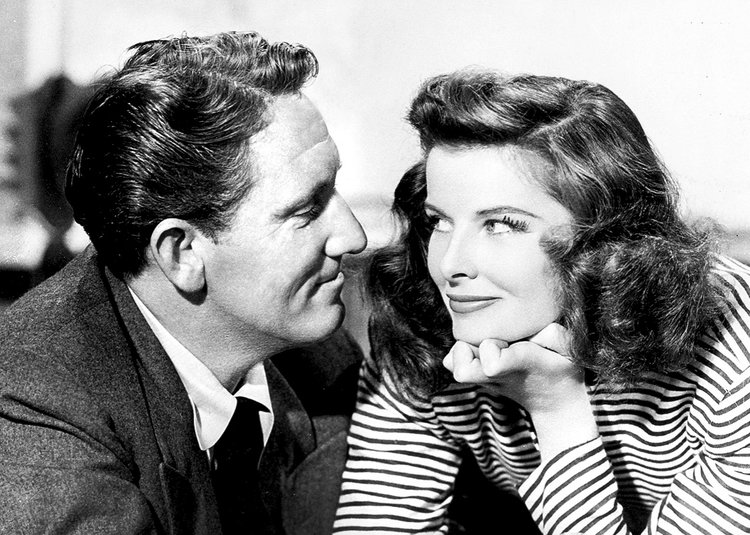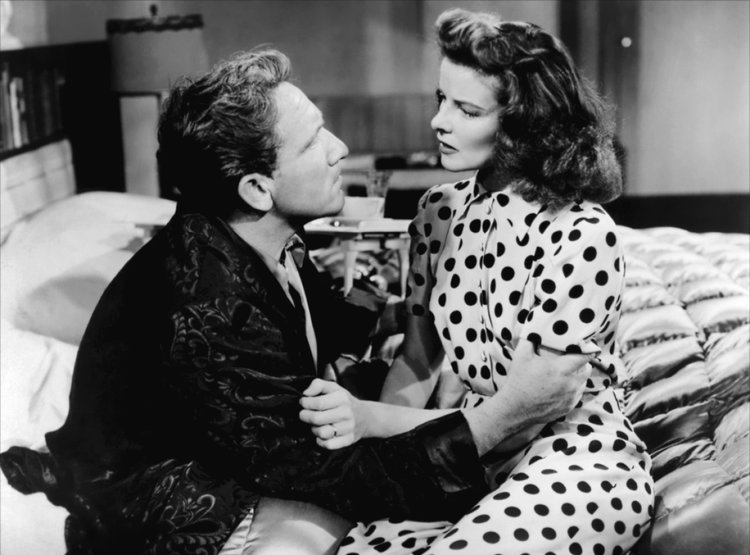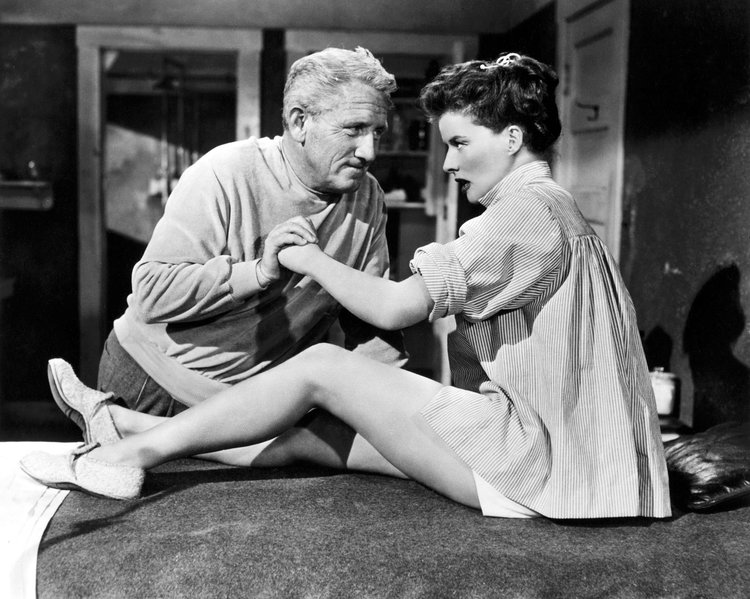I wrote this blog for Night Owl TV and it first appeared on their site on December 28, 2017. A link to that post and other Night Owl TV material can be found here.

Katharine Hepburn and Spencer Tracy combined to create one of the great cinematic duos of all time. All told, they made nine films together, and many of them are some of the best-known of the 20th Century. Their onscreen chemistry reflected their 25-year love affair that neither could acknowledge but was perhaps the worst kept secret in Hollywood. Hepburn herself never acknowledged the affair until she released her memoir after Tracy’s wife died in 1983.
Whatever went on between these two great actors off screen only enhanced what they created onscreen. Individually each was a powerhouse actor, and individually they starred in some of American cinema’s most important films. Tracy was the driving force behind such magnificent films as Boys Town, Inherit the Wind and Judgment at Nuremberg while Hepburn’s star shined brightest in films like The Philadelphia Story, The African Queen and The Lion in Winter. Each actor brought signature elements to their performances. Tracy had an idealistic pragmatism with a sarcastic wit that could be either disarming or could cut you to the core. Hepburn on the other hand, was a torchbearer for cinematic feminism and rebelliousness that showed a generation of women filmgoers that they need not take a back seat to anyone.

When these two got together on film, their individual idiosyncrasies played off each other and created chemistry that was pure joy to watch. What’s more, when you watch Tracy and Hepburn on screen, it looks like they’re having as much fun as the audience. That chemistry translated into performances that have become classic and iconic. The reason for this is that their best work involves characters who do ordinary things, but somehow end up with extraordinary results. The characters in their films, whether they’re research librarians, reporters, athletes, or lawyers are relateable to us, and end up overcoming their struggles in realistic ways that show their true strength of character. They’re not glamorous. They’re not heroic in the traditional sense. They’re usually every day heroes with flaws, both internal and external, that allow us to walk in their shoes, suffer their failures and revel in their successes.
Any fan of classic cinema should be a fan of the work of Tracy and Hepburn. The nine films they made together may differ in genre and in style, but vary little in quality. They’re all terrific films, but for the sake of brevity, I’ll run down the top-5. If you’re unfamiliar with their work, these would be great films to start out with to familiarize yourself with their charm and their style. It’s impossible not to recommend all nine, but here are the first five that you should see. Together they demonstrate the magic that these two seemingly so effortlessly created.
5. Woman of the Year (1942)

The first film they starred in together, Woman of the Year introduced us to the motifs and idiosyncrasies that would play such a prevalent role in their work together. Playing reporters who write for the same newspaper, Sam (Tracy) is a sports reporter with traditional values and Tess (Hepburn) is a progressive feminist who wins an award for Woman of the Year. The movie gets going when they fall in love and get married, but Tess’s busy schedule leads Sam to feel neglected. Like so many of their films, this one was ahead of its time in terms of the thematic issues it dealt with. More women would be entering the work force in the coming years, and gender roles were beginning to become cloudy. Woman of the Year took a close look at how both women and men were going to have to change in order to solve this evolving dynamic.
4. Pat and Mike (1952)

Directed by George Cukor, this is another classic Tracy and Hepburn film that examines gender roles. Pat (Hepburn) is a female athletic sensation who can swing a tennis racquet or a golf club with equal ease. Mike (Tracy) is a shady sports manager who looks at Pat as a possible meal ticket before falling in love with her. One of the motifs that makes this film great is Mike’s terrific character arc from shady manager to a man who appreciates Pat for who she is. Unlike Pat’s overbearing fiancé, Collier Weld, Mike falls in love with Pat for who she is, not for who he wants her to be. Watching this relationship build as they sneak around to avoid Collier as well as jealous boxer Davie Hucko (Aldo Ray) and the mob, is as fun and entertaining as movies can be.
3. Adam’s Rib (1949)

While it’s still a romantic comedy, Adam’s Rib is one of the most dramatic films that Tracy and Hepburn starred in together. Tracy plays Assistant District Attorney Adam Bonner who is assigned to prosecute Doris Attinger (Judy Holiday), who shot her husband after catching him in an affair. He expects a quick win until the unexpected happens. Bonner’s wife, Amanda (Hepburn) is a defense attorney who feels sympathetic to Doris and takes on her case. What more dramatic situation could there be than a husband and wife on opposite sides of the same trial? Another film directed by George Cukor, Adam’s Rib contains one of the signature moments in Tracy and Hepburn’s remarkable partnership when they’re giving each other rub downs, and he smacks her backside just a little too hard. The competitive spirit between them has turned unhealthy for their relationship, and we, as the audience, fear that it could spell the end for them. Adam’s Rib is a thoughtful film that makes us examine our own preconceived ideas of right and wrong, and that the notions of morality, ethics and legality don’t always fit neatly together.
2. Desk Set (1959)

This is another film that was ahead of its time, as it shows the dangers of automation for people and their employment. It also shows that automation might not be the panacea that many people of the time believed that it would be. Tracy plays Richard Sumner, a computer developer who is working to bring a new computer into the reference department of a television network. Hepburn is Bunny Watson, the head of that department who can recall almost any fact with ease. This film had a bit of a role reversal for them, as it was Tracy’s character who’s looking towards the future with this new technology, and Hepburn is holding on to the tried and true processes of the traditional library. Throw in a love triangle with the very funny Gig Young who plays a wanna-be executive who’s been stringing Bunny along romantically for years, as well as a jaded yet hopeful sidekick played by Joan Blondell, and you have the ingredients for a charming and funny film. And yet, it’s a film that still takes a hard look at modernization with a 50’s optimism that everything will turn out all right in the end.
1. Guess Who’s Coming to Dinner (1967)

The final film that Tracy and Hepburn starred in together. Tracy passed away shortly after shooting wrapped and before the film was released. Hepburn reportedly never watched the final version of it, citing that it was too painful to do so. Also starring Sidney Poitier, this film was a passing of the torch from Tracy and Hepburn’s generation to Poitier’s and it was a thoughtful and emotional film about confronting prejudices you never even knew you had. That’s just what Matt Drayton (Tracy) and his wife Christina (Hepburn) must do when their daughter Joanna returns from Europe affianced to Dr. Ben Prentice (Poitier). The two of them (but Matt in particular) wrestle with the notion of the difficulties their daughter will have in an interracial marriage before they can give their approval in yet another film that was years ahead of its time. During Tracy’s final heartfelt monologue, Hepburn can be seen shedding real tears. She knew this was Tracy’s swan song, he’d soon be gone, and she was overcome with her own emotion. Guess Who’s Coming to Dinner was nominated for Best Picture of 1967 and also was on AFI’s original list of the Top 100 films of all time. If you’ve never seen it, it should be high on your list.
Just saying the names Tracy and Hepburn stirs up memories and passions in many fans of classic cinema. Much of the work the two of them did individually is classic. All of the work they did together was timeless.